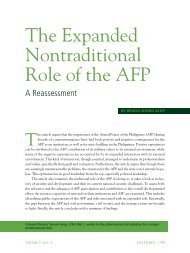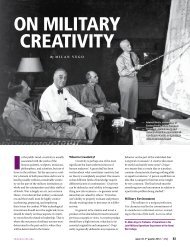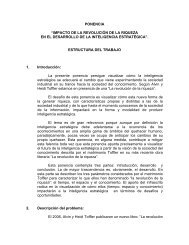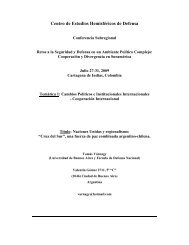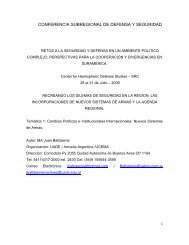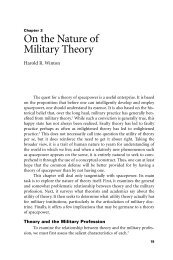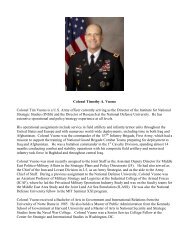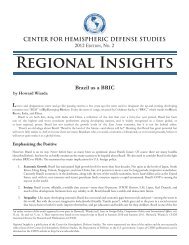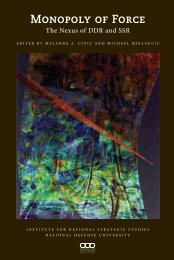In the second half of the 20th century, the US enjoyed pre-eminence ...
In the second half of the 20th century, the US enjoyed pre-eminence ...
In the second half of the 20th century, the US enjoyed pre-eminence ...
Create successful ePaper yourself
Turn your PDF publications into a flip-book with our unique Google optimized e-Paper software.
S&T is moving from a situation where <strong>the</strong> United States was <strong>the</strong> principal generator <strong>of</strong> scientific<br />
knowledge to one where most scientific knowledge will emerge from economies o<strong>the</strong>r than <strong>the</strong><br />
United States. It will become increasingly difficult for <strong>the</strong> United States to maintain an<br />
authoritative awareness <strong>of</strong> <strong>the</strong> state <strong>of</strong> S&T. A related development is that private companies are<br />
becoming increasingly global in character and will become difficult to associate with a particular<br />
nation. However, <strong>the</strong>se entities may gain a better global view <strong>of</strong> S&T than any one nation, which<br />
could ei<strong>the</strong>r help or hinder <strong>the</strong> matter <strong>of</strong> maintaining an authoritative awareness <strong>of</strong> world S&T.<br />
We are also seeing <strong>the</strong> emergence <strong>of</strong> global S&T initiatives (<strong>the</strong> human genome project, climate<br />
change, Large Hadron Collider, ITER, etc.). Fur<strong>the</strong>rmore, <strong>the</strong> impact <strong>of</strong> modern IT and <strong>the</strong><br />
evolution <strong>of</strong> a new communication infrastructure greatly facilitate global collaboration in S&T<br />
(e.g., about one-third <strong>of</strong> U.S. scientific publications are now published in collaboration with<br />
o<strong>the</strong>r countries). These are pr<strong>of</strong>ound changes, and we are only at <strong>the</strong> beginning <strong>of</strong> <strong>the</strong><br />
globalization <strong>of</strong> S&T. Keeping up with <strong>the</strong>se changes will be challenging for <strong>the</strong> United States<br />
and especially for DOD. The United States (including DOD) will need to balance <strong>the</strong> benefits <strong>of</strong><br />
controlling S&T information to <strong>pre</strong>serve military and economic advantages with <strong>the</strong> benefits <strong>of</strong><br />
open exchange <strong>of</strong> S&T information to exploit global knowledge for U.S. interests. This will be a<br />
nontrivial and dynamic calculus. As with most balancing acts, leaning too far in one direction<br />
will have a negative outcome.<br />
Most nations have in place procedures to <strong>pre</strong>vent <strong>the</strong> release <strong>of</strong> information that could endanger<br />
<strong>the</strong>ir national or economic security. <strong>In</strong> <strong>the</strong> area <strong>of</strong> national security, a major means <strong>of</strong> control has<br />
been <strong>the</strong> security classification system. The U.S. security classification system is very well<br />
developed and has three basic classification levels: Top Secret, Secret, and Confidential. These<br />
categories are defined in Executive Order 12356. The security classification system applies to<br />
S&T information that has been derived fully or in part from federal funding. <strong>In</strong> general, it has<br />
been national policy that fundamental research (as defined in National Security Decision<br />
Directive 189) funded by federal funds should, to <strong>the</strong> maximum extent possible, be unrestricted.<br />
There are, <strong>of</strong> course, procedures for classifying a fundamental research program in <strong>the</strong> event it is<br />
deemed necessary (e.g., Executive Orders 12958 and 13292).<br />
A fourth category, referred to as Sensitive But Unclassified (SBU), is <strong>of</strong>ten invoked. This<br />
category has no statuary definition and has been <strong>the</strong> subject <strong>of</strong> considerable debate over <strong>the</strong> past<br />
years. This debate became especially loud after 9/11 when steps were taken to attempt to deny<br />
terrorists information that might be unclassified but helpful to <strong>the</strong>ir cause. Unlike classified<br />
information, which generally has well-defined classification criteria, <strong>the</strong> SBU category is <strong>of</strong>ten<br />
ambiguous and characterized by subjective decisionmaking. <strong>In</strong> 2006 <strong>the</strong> Congressional Research<br />
Service <strong>pre</strong>pared a report on this matter and <strong>the</strong> various positions and options associated with<br />
it. 39 <strong>In</strong> 2008 <strong>the</strong> White House issued a memorandum for <strong>the</strong> heads <strong>of</strong> executive departments and<br />
agencies. It instituted <strong>the</strong> “Controlled But Unclassified <strong>In</strong>formation [CBU])” category that<br />
incorporated most <strong>of</strong> what was generally placed into <strong>the</strong> SBU category. 40 This memorandum was<br />
followed by <strong>the</strong> establishment <strong>of</strong> <strong>the</strong> <strong>In</strong>teragency Taskforce on Controlled but Unclassified<br />
39 See http://www.law.umaryland.edu/marshall/crsreports/crsdocuments/RL33303_02152006.pdf.<br />
40 See http://georgewbush-whitehouse.archives.gov/news/releases/2008/05/20080509-6.html.<br />
27



